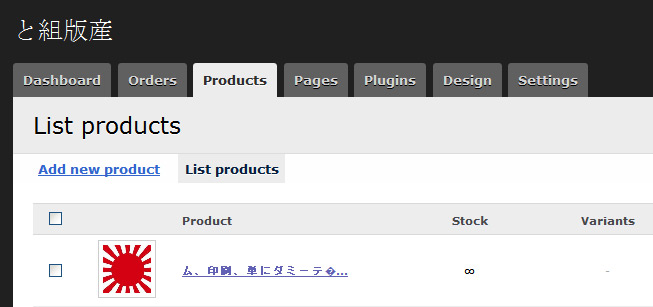What we’ve been doing in August
Language support UTF8/Unicode
From the very beginning, we have planned on making SolidShops a niche product for people that need an easy and enjoyable way to run and setup an online store. This niche seems to be web designers, web agencies as well as individual store owners from all over the world.
We’ve been working hard this month to make SolidShops as compatible as possible with any language out there. To take the test to an extreme, we’ve done some testing with Japanese and Arabic texts and support is almost fully there.
A note to Japanese readers out there: we don’t speak Japanese and just translated some Lorem Ipsum text in Google Translate, so don’t be offended by whatever shows up in the screenshots ;).
Frontpage and content page design
Right now, the only thing up on solidshops.com is a frontpage and no ability to take a tour or signup for an account yet. While all those pages have been developed and are working great, we are still finalizing a number of things before putting SolidShops in its whole out there. You can read more about what we still need to do before launching later in this post.
Bugfixing
We’ve conducted a number of technical testing rounds as well as usability tests with non-technical users to get some initial feedback on the application.
In general, results where great, but of course a number of bugs showed up that needed fixing, as well as a few usability problems that we have been taking care of. We could have fixed these things after going live, but as you will read later, we still have some things to do before being able to launch.
By the way, if anyone involved in running a startups is reading this, we use the amazing FogBugz app to track and manage our bugs. If you don’t do so already, be sure to get it.
Automated deployment and upgrades
As we wrote in a previous post we have been working hard on automating a number of flows in our development process. One of those flows is deployment. When we write bug fixes or build new features, we want these changes to roll out automatically to our production web server without interrupting the user process. This usually involves a number of steps like:
- getting code from code respository
- uploading the code to the server
- making sure permissions are safe
- minifying and compressing CSS & JavaScript for better performance
- pointing the web server to the newest version of the code without interrupting the user
I probably even forgot a few steps we are doing every time we have a new codebase ready. Of course, all these steps are prone to human error so we automated everything in such a way that errors are avoided at all times and nothing dramatically can happen when deploying. That’s the only way it should be, but it took us quite some time to get to that point.
What’s still ahead?
Most of the application is ready. What we are focusing on right now is integrating and testing payments with PayPal, the first payment gateway we’ll be supporting. The checkout process and pages are in place, but they need some serious testing and a number of code tweaks before we can put them in the live release.
One of the features web designers are going to love is the possiblity to create 100% custom templates. For that we have implemented an easy to use templating language. The language itself is easy enough, but it still requires clear documentation for developers to dive into when needed. We are in the process of writing this documentation and setting up a support system to manage any support requests we might get.
Release date
We have set a launch date and deadline for ourselves already. Somewhere in the next few weeks you’ll be the first to know when we launch by reading our Blog or just by following us on Twitter. If you haven’t signed up yet for a beta invitation, do so now on our frontpage!



Let's get social shall we?
We'd love to know what you think. Join the conversation about your hosted e-commerce solution.